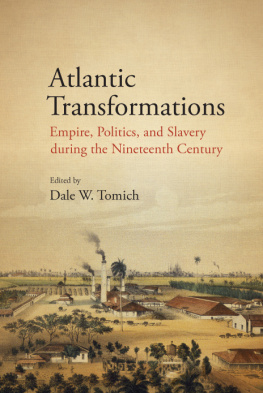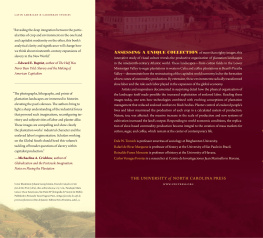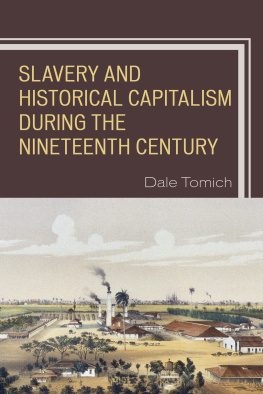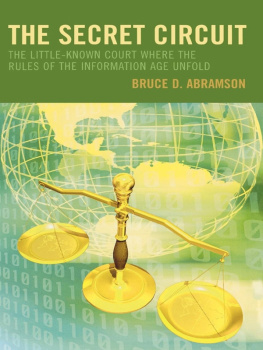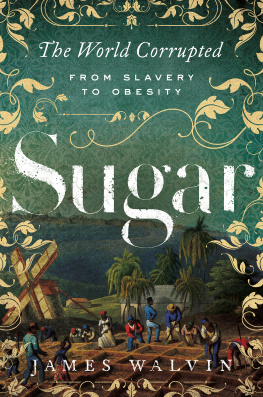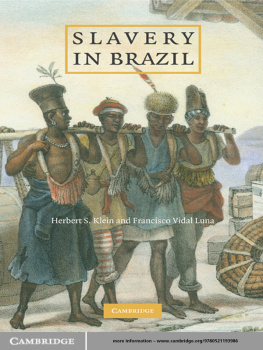
Slavery in the
Circuit of Sugar
FERNAND BRAUDEL CENTER
STUDIES IN HISTORICAL SOCIAL SCIENCE
Series Editor: Richard E. Lee
The Fernand Braudel Center Studies in Historical Social Science will publish works that address theoretical and empirical questions produced by scholars in or through the Fernand Braudel Center or who share its approach and concerns. It specifically seeks to promote works that contribute to the development of the world-systems perspective engaging a holistic and relational vision of the worldthe modern world-systemimplicit in historical social science, which at once takes into consideration structures (long-term regularities) and change (history). With the intellectual boundaries within the sciences/social sciences/humanities structure collapsing in the work scholars actually do, this series will offer a venue for a wide range of research that confronts the dilemmas of producing relevant accounts of historical processes in the context of the rapidly changing structures of both the social and academic world. The series will include monographs, colloquia, and collections of essays organized around specific themes.
VOLUMES IN THIS SERIES:
Questioning Nineteenth-Century Assumptions about Knowledge I: Determinism
Richard E. Lee, editor
Questioning Nineteenth-Century Assumptions about Knowledge II: Reductionism
Richard E. Lee, editor
Questioning Nineteenth-Century Assumptions about Knowledge III: Dualism
Richard E. Lee, editor
The Longue Dure and World-Systems Analysis
Richard E. Lee, editor
New Frontiers of Slavery
Dale W. Tomich, editor
Slavery in the Circuit of Sugar, Second Edition: Martinique and the World Economy, 18301848
Dale W. Tomich
Slavery in the
Circuit of Sugar
Martinique and the World-Economy,
18301848
SECOND EDITION
Dale W. Tomich
FERNAND BRAUDEL CENTER
STUDIES IN HISTORICAL SOCIAL SCIENCE
Published by State University of New York Press, Albany
2016 State University of New York
All rights reserved
Printed in the United States of America
No part of this book may be used or reproduced in any manner whatsoever without written permission. No part of this book may be stored in a retrieval system or transmitted in any form or by any means including electronic, electrostatic, magnetic tape, mechanical, photocopying, recording, or otherwise without the prior permission in writing of the publisher.
For information, contact State University of New York Press, Albany, NY
www.sunypress.edu
Production, Ryan Morris
Marketing, Kate R. Seburyamo
Library of Congress Cataloging-in-Publication Data
Tomich, Dale W., 1946
Slavery in the circuit of sugar : Martinique and the world economy, 18301848 / Dale W. Tomich. Second edition.
pages cm. (SUNY series, Fernand Braudel Center studies in historical social science)
Includes bibliographical references and index.
ISBN 978-1-4384-5917-2 (hardcover : alk. paper)
ISBN 978-1-4384-5918-9 (e-book)
1. SlaveryMartiniqueHistory19th century. 2. Slave laborMartiniqueHistory19th century. 3. Sugarcane industryMartiniqueHistory19th century. 4. Sugar tradeMartiniqueHistory19th century. 5. Sugar tradeHistory19th century. 6. MartiniqueEconomic conditions. I. Title.
| HT1108.M3T66 2016 |
| 306.3'62097298209034dc23 | 2015005370 |
10 9 8 7 6 5 4 3 2 1
For my parents,
John and Dorothy Tomich
TABLES
ILLUSTRATIONS
| The Dutrne Table: Distribution of the Slave Labor Force throughout the Agricultural Year |
FOREWORD
The Fernand Braudel Center for the Study of Economies, Historical Systems, and Civilizations is pleased to present this revised edition of Slavery in the Circuit of Sugar: Martinique and the World-Economy, 18301848 , by Dale Tomich, part of its series Studies in Historical Social Science produced in collaboration with the State University of New York Press. Its original 1990 imprint has long been unavailable; its reissue with a new introduction and conclusion responds to a contemporary renewal of interest in analyses of capitalism and the world-economy that relate local trajectories to what now have become global processes. The book won the Political Economy of the World-System Section of the American Sociological Association Book Award in 1991. It develops and extends the world-systems perspective to treat the formation of local spaces and their specific social relations as instances of the long-term, large-scale processes of historical capitalism, whatever their forms of labor force control.
In this distinctive analysis, the circuit of sugar links the histories of plantation production based on slave labor to wage labor regions. Thus, what we have is a distinctive and original contribution that is at once about Martinique and the world as a symbiotic, mutually determinative relationship. This treatment of the sugar-slavery complex in Martinique in terms of sugar production and its technology, slave provision grounds, and the labor processand resistancehas long been regarded as outstanding in the field.
The reissue of this classic text will be much appreciated by a wide range of scholars, the more so as this revised edition of Slavery in the Circuit of Sugar also includes a new introduction in which the author offers an explicit discussion of the methodological and theoretical issues entailed in developing and extending the world-systems perspective and clarifies the importance of the approach for the study of particular histories.
R ICHARD E. L EE
PREFACE TO THE SECOND EDITION
It is twenty-five years since the initial publication by the Johns Hopkins University Press of Slavery in the Circuit of Sugar , and a number of colleagues and friends have encouraged me to make it available again. It is rewarding to find that the book continues to be a reference for scholars in a number of disciplines, both for its substantive historical account of sugar and slavery in Martinique within the formation of the nineteenth-century world-economy, and for its distinctive analytical approach to social historical change. It is, of course, possible to incorporate new data into the study, and some arguments I would now make differently. However, such changes would not substantively alter the analysis presented in the book. For this reason, I have not changed the body of the text, with the exception of the conclusion. I have always found endings to be difficult, and I have used the occasion of this new edition to attempt a more satisfactory conclusion than the original. In addition, I have written an introduction to this new edition that presents the influences that shaped the writing of Slavery in the Circuit of Sugar . My intention is that this new introduction will give readers, especially younger scholars, a better understanding of how and why the book was written. In particular, this introduction addresses problems of theory and method more explicitly than does the book. It analyzes the limitations of both Marxist and world-systems approaches to the conceptualization of the relation of slavery and capitalism, and above all, explicates the theoretical approach to the reinterpretation of slavery and the reconstruction of specific local histories within a world-systems perspective that I developed in the course of writing the book.


